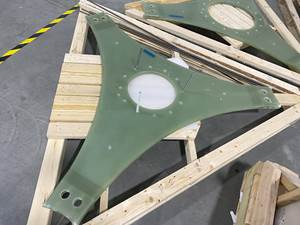New research collaboration to advance efforts to 3D print with wood products
The ORNL and UMaine research team will work with the forest products industry to produce new bio-based materials that will be conducive to 3D printing a variety of products.
A new research collaboration between the University of Maine (Orono, Maine, U.S.) Advanced Structures and Composites Center and the Department of Energy’s Oak Ridge National Laboratory (ORNL, Oak Ridge, Tenn., U.S.) aims to advance efforts to 3D print with wood products.
U.S. Sens. Susan Collins (Maine), Lamar Alexander (Tenn.) and Angus King (Maine) joined Daniel Simmons, assistant secretary for energy efficiency and renewable energy at the U.S. Department of Energy, as well as leaders from UMaine and ORNL in Washington, D.C., May 2 to announce the launch of the large-scale, bio-based additive manufacturing program.
The ORNL and UMaine research team will work with the forest products industry to produce new bio-based materials that will be conducive to 3D printing a variety of products, such as boat hull molds, shelters, building components, tooling for composites and wind blades. They also will position the industry to print large, structurally demanding systems, such as boats.
“The development of sustainable, inexpensive wood-based materials for large-scale 3D printing has the potential to invigorate Maine’s forest products industry,” says Collins. “This project is an outstanding example of our national labs working cooperatively with universities to drive American innovation and strengthen our economy.”
“The partnership between the University of Maine and the Oak Ridge National Laboratory is a model for how science and technology can help Americans prosper in the new economy,” says Alexander.
“Maine’s forest products industry is central to our state’s identity, and plays a leading role in our economy, which is why bringing innovation and creativity to the Maine woods is so important,” says King. “I can think of no partnership more capable of advancing the industry than the world-class research institutions at University of Maine and Oak Ridge National Laboratory.”
The $20 million effort, funded by DOE’s Advanced Manufacturing Office, aims to strengthen regional manufacturing by connecting university–industry clusters with DOE’s Manufacturing Demonstration Facility (MDF) at ORNL, says Daniel Simmons, assistant secretary in the DOE Office of Energy Efficiency and Renewable Energy. MDF will enable regional industries to apply decades of experience in a short period of time to more effectively translate additive manufacturing technology to the region’s strengths.
“This partnership will allow our faculty and students to work seamlessly with Oak Ridge researchers, learn, innovate and strengthen local manufacturing,” says UMaine President Joan Ferrini-Mundy.
ORNL is a world leader in advanced manufacturing and is DOE’s largest science and energy laboratory, conducting basic and applied research to deliver transformative solutions to compelling problems in energy and security. UMaine is a world leader in cellulose nano fiber (CNF) technology, including development of nano- and micro-cellulose reinforced thermoplastic composites through its Advanced Structures and Composites Center.
“The University of Maine is doing cutting-edge research related to bio-feedstocks and the application of advanced manufacturing in regional industries. We are thrilled at this opportunity to expand our research base while providing UMaine with access to the leading national capabilities we have developed at ORNL’s Manufacturing Demonstration Facility,” says Thomas Zacharia, director of ORNL.
The collaboration will provide students, faculty and companies associated with UMaine’s Advanced Structures and Composites Center access to ORNL’s assets and expertise in advanced manufacturing. ORNL researchers, in turn, will gain access to UMaine’s facilities and expertise in CNF and composites. Scientists from ORNL and UMaine will conduct fundamental research in several key technical areas, including CNF production, drying, functionalization, and compounding with thermoplastics, multiscale modeling and sustainability life-cycle analysis. By placing CNF into plastics, strong, stiff and recyclable bio-derived material systems can be developed that may be 3D printed at deposition rates of hundreds of pounds per hour and up to 50 percent cellulose fiber loading. Printing with 50 percent wood promises to open new markets for the pulp, paper and forest products industries.
Habib Dagher, executive director of UMaine’s Advanced Structures and Composites Center characterized the initiative as being like “putting together the NBA All-Star team for massive 3D printing with wood.”
“We will integrate 20 years of research in bio-based composites at UMaine and 3D printing at ORNL,” Dagher said. “It is an opportunity engine for our students, faculty, staff and manufacturing industry who will work side by side with researchers at our nation’s foremost research laboratory. Together, we will break down wood to its nanocellulose structure, combine it with bioplastics, and print with it at hundreds of pounds an hour. The research we will be conducting with ORNL will spur next-generation manufacturing technologies using recyclable, bio-based, cost-effective materials that will bolster our region’s economy.”
Related Content
ZEBRA project demonstrates closed-loop wind recycling system
Consortium partners have proven the complete recycling of thermoplastic wind turbines via two manufactured wind blades, featuring reduced operating cost, CO2 emissions.
Read MoreRevolutionizing space composites: A new era of satellite materials
A new approach for high volumes of small satellite structures uses low-CTE, low-cost CFRP cellular core, robust single-ply skins and modular panel systems to cut lead time, labor and cost for reflectors, solar arrays and more.
Read MoreComposites end markets: Batteries and fuel cells (2024)
As the number of battery and fuel cell electric vehicles (EVs) grows, so do the opportunities for composites in battery enclosures and components for fuel cells.
Read MoreRTM, dry braided fabric enable faster, cost-effective manufacture for hydrokinetic turbine components
Switching from prepreg to RTM led to significant time and cost savings for the manufacture of fiberglass struts and complex carbon fiber composite foils that power ORPC’s RivGen systems.
Read MoreRead Next
Next-gen fan blades: Hybrid twin RTM, printed sensors, laser shock disassembly
MORPHO project demonstrates blade with 20% faster RTM cure cycle, uses AI-based monitoring for improved maintenance/life cycle management and proves laser shock disassembly for recycling.
Read MoreScaling up, optimizing the flax fiber composite camper
Greenlander’s Sherpa RV cab, which is largely constructed from flax fiber/bio-epoxy sandwich panels, nears commercial production readiness and next-generation scale-up.
Read MoreCeramic matrix composites: Faster, cheaper, higher temperature
New players proliferate, increasing CMC materials and manufacturing capacity, novel processes and automation to meet demand for higher part volumes and performance.
Read More












